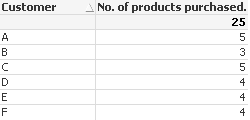Unlock a world of possibilities! Login now and discover the exclusive benefits awaiting you.
- Qlik Community
- :
- All Forums
- :
- QlikView App Dev
- :
- Re: How to calculate Sum of Means ?
- Subscribe to RSS Feed
- Mark Topic as New
- Mark Topic as Read
- Float this Topic for Current User
- Bookmark
- Subscribe
- Mute
- Printer Friendly Page
- Mark as New
- Bookmark
- Subscribe
- Mute
- Subscribe to RSS Feed
- Permalink
- Report Inappropriate Content
How to calculate Sum of Means ?
Help me write some expressions, attached is the sample document
My first chart i.e. "Avg Mean Price Per Product" would be like
Sum(Mean price of all purchases of a customer)/Total Number of Customers
My first chart i.e. "Avg Mean Price Per Product" would be like
Sum(Max price of all purchases of a customer)/Total Number of Customers
*** There can be multiple purchases for a product against single customer. I have updated the document too.
Any help is highly appreciated.
Message was edited by: Mubbasher Khaliq (Multiple purchases for a product against single customer added)
- « Previous Replies
-
- 1
- 2
- Next Replies »
Accepted Solutions
- Mark as New
- Bookmark
- Subscribe
- Mute
- Subscribe to RSS Feed
- Permalink
- Report Inappropriate Content
You should add Customer as dimension to aggr, otherwise you choose to calculate aggr() regardless of customer (aka total<> modifier).
Read the help about aggr() function.
- Mark as New
- Bookmark
- Subscribe
- Mute
- Subscribe to RSS Feed
- Permalink
- Report Inappropriate Content
If you want to average per customer, then sum the averages, you should use
Sum(Aggr(Avg(Price),Customer))
HIC
- Mark as New
- Bookmark
- Subscribe
- Mute
- Subscribe to RSS Feed
- Permalink
- Report Inappropriate Content
Hi.
aggr() function can help you to calculate the expression for the aggregation level that differs from the chart dimensions.
- Mark as New
- Bookmark
- Subscribe
- Mute
- Subscribe to RSS Feed
- Permalink
- Report Inappropriate Content
Here it is
- Mark as New
- Bookmark
- Subscribe
- Mute
- Subscribe to RSS Feed
- Permalink
- Report Inappropriate Content
Hi,
Have a look on RangeAvg() function.
- Mark as New
- Bookmark
- Subscribe
- Mute
- Subscribe to RSS Feed
- Permalink
- Report Inappropriate Content
See the attached file
- Mark as New
- Bookmark
- Subscribe
- Mute
- Subscribe to RSS Feed
- Permalink
- Report Inappropriate Content
Thanks, This helped me a lot , but when I write this expression
If within Aggr function I use Sum/Count rather than Avg then the out put of Count is not right. As can be seen below.
Expression:
Sum(Aggr(Count(1),Product))
Output:

Why it is counting every product count against single customer.
Desired Output:

- Mark as New
- Bookmark
- Subscribe
- Mute
- Subscribe to RSS Feed
- Permalink
- Report Inappropriate Content
Please check my reply to above post. Thanks.
- Mark as New
- Bookmark
- Subscribe
- Mute
- Subscribe to RSS Feed
- Permalink
- Report Inappropriate Content
You should add Customer as dimension to aggr, otherwise you choose to calculate aggr() regardless of customer (aka total<> modifier).
Read the help about aggr() function.
- Mark as New
- Bookmark
- Subscribe
- Mute
- Subscribe to RSS Feed
- Permalink
- Report Inappropriate Content
Since QV can't choose the customer to show the result it takes the first one.
To make the aggr() working as total modifier you should add 'nodistinct', then QV repeats 25 for each customer.
- « Previous Replies
-
- 1
- 2
- Next Replies »